Different Types Of Grass Fungus In Lawn & Yards
If you find red thread-like grass or spot a brown, gray, straw colored irregular moldy patch in your yard, it could be a sign of lawn fungus.
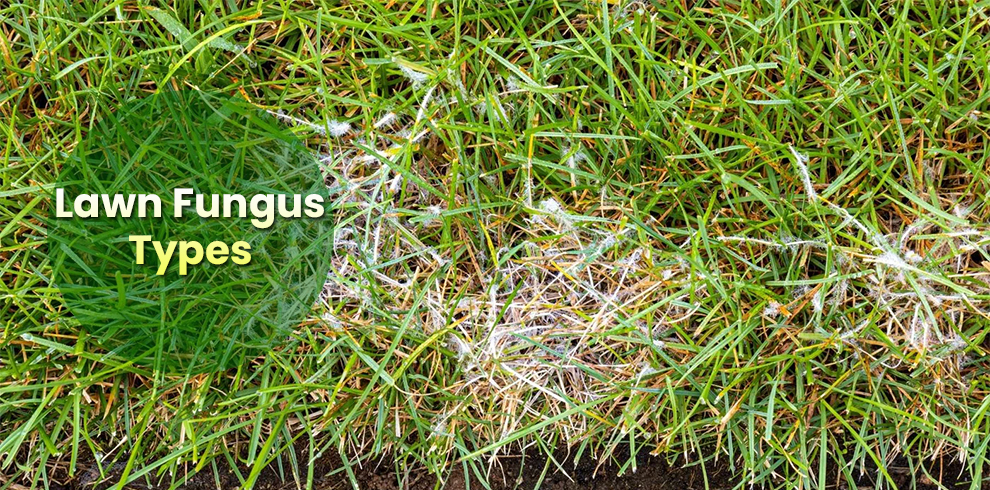
Fortunately, most of the grass fungus kinds are not a threat to your yard. Sometimes the outbreak might result from an extended period of humidity and heat, but for the most part, your lawn will be disease-free, provided you take apt steps toward its maintenance.
Golf courses and sports fields are most susceptible to these kinds of lawn fungus types because of the intense conditioning and extensive use, but rarely will a homeowner have to apply a fungicide to combat or prevent them.
But if you find a dying or dead spot in the lawn, it might be a yard fungus infection in your garden. Knowing its identification can help you understand its cause and take adequate preventive and remedial measures. Sadly, many types of fungus infect your grass, but the most prevalent ones include powdery mildew, brown patch, and red thread.
After you carefully fertilize and manicure your lawns, the last thing you probably want to see is defects. When defects, such as yellowing and bare spots, arise, you might think fertilization and watering are the remedial actions.
However, it might because of one of the multiple types of grass fungus that demands more than just maintenance. This guide will take you through the prevalent lawn fungus that might infect your grass, their identification, and ways to combat and prevent them. We will also discuss how harmful they may be to your turf.
How Do I Identify Lawn Fungus?
You can look out for the following signs and know which among the different types of yard fungus has affected your lawn.
1. Stunted growth: If the lawn does not grow properly or looks weaker, it might indicate a fungal infection.
2. White or gray powdery substance: Some fungi generate a powdery substance that appears on the grass blades.
3. Discolored patches: Inspect the areas in the lawn that are yellow, brown, or red, as that might be a sign of fungal infection.
4. Toadstools or mushrooms: Some fungi yield toadstools or mushrooms spotted on the grass surface.
5. Circular patches: Several fungal diseases might result in circular patches of dying or dead grass showing on the ground.
Different Types Of Lawn Fungus
Several diseases affect your lawn fungus if you do not expose them to proper conditions. However, a few of the most prevalent ones are discussed below:
A. Rust disease
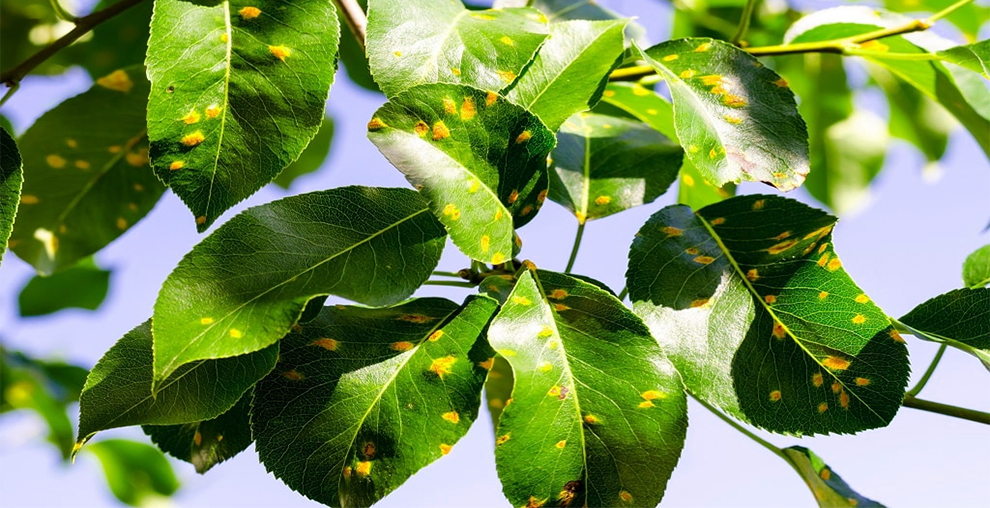
It is one of the most common lawn fungi. Rust disease is most prevalent between fall and spring when the temperature is between 68 to 86 degrees Fahrenheit, as the fungus responsible thrives in the wet weather.
However, it might also crop up in humid or after a spell of wet weather. While this disease can affect any grass, it is most prevalent in Kentucky bluegrass, tall fescue, ryegrass, and Roisa grass.
How do I identify it?
Yellow, irregular patches across the grass are a giveaway sign of rust disease. You may also find tiny yellow marks on the individual grass blades. Once the disease spreads, the fleck rupture and envelop the grass in a light-yellow powder that rubs off on the pants and shoes as you pass the yard.
Treatment
Maintenance is the best way to prevent and treat rust disease. You must water and fertilize the lawn as recommended. Initially, things should improve after this, but if you do not see any improvement in three weeks, you might have to use a fungicide with propiconazole.
B. Dollar spot
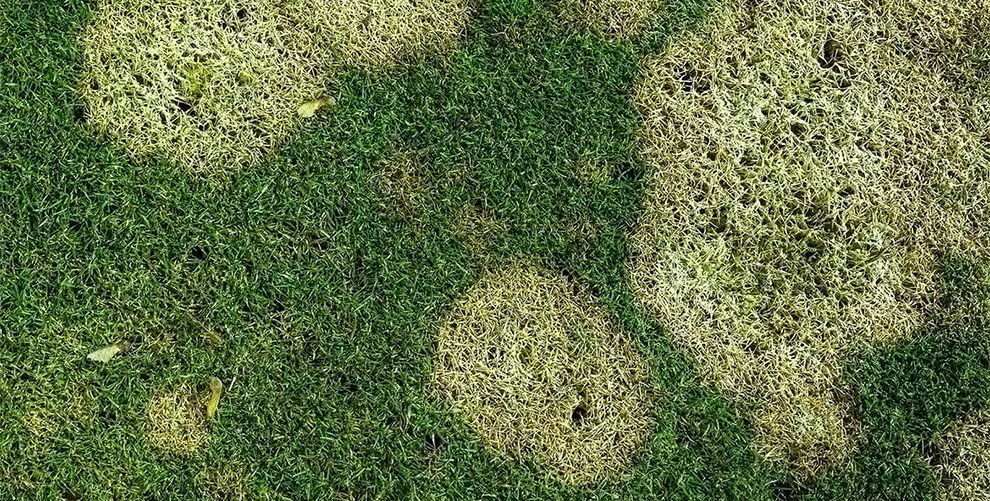
It is another one of the lawn fungus types that refers to the small, circular, sunken patch about 1.5 to 5 cm in diameter seen on the lawn surface. Dollar Spot usually occurs because of poor lawn care or inadequate nutrients in the soil.
Poor drainage, soil compaction, thatch build-up, and watering at night are the prevalent causes. These are most common in spring and autumn because of warm temperatures during the day, cool nights with heavy dews, and high humidity in the evening.
How do I identify it?
The patches change from brown to a straw color on the yard and merge into more irregular, larger shaped areas. You will find small lesions on the infected leaves. Over time, they turn from yellow-green to straw color with a reddish-brown border.
Treatment
Proper lawn care maintenance is the best prevention and treatment. With proper maintenance, you can achieve a healthy lawn.
Some steps you need to take include reduction of the thatch levels, mowing at regular intervals, feeding adequate fertilizer, morning watering that is infrequent but deep, and aeration. However, if these things do not help combat the fungus, you can use fungicides with propiconazole.
C. Brown patch
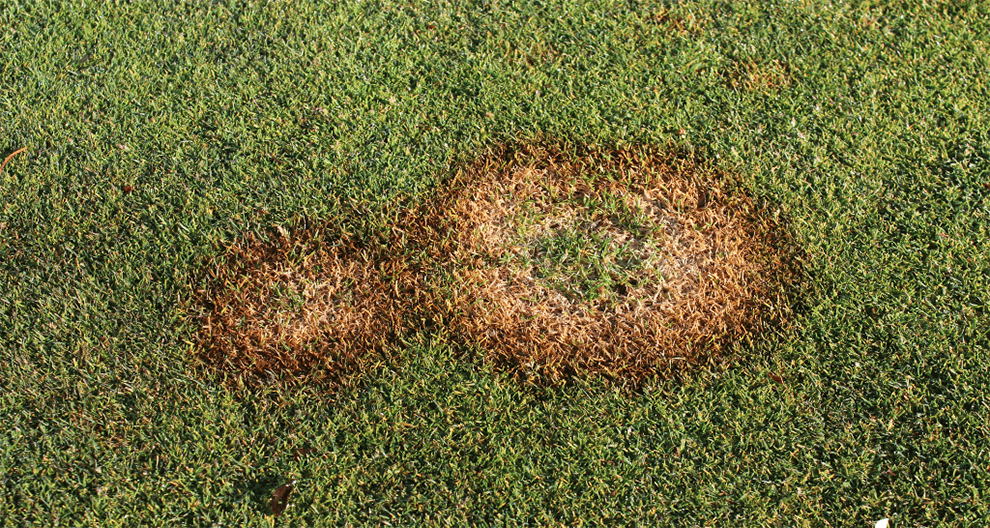
Brown patch can affect all cool-season lawn grasses but is particularly harmful to tall fescue and ryegrass. However, fine fescues and Kentucky bluegrass are occasionally affected. However, the damage is minimal in these species. The brown patch might affect warm-season grass like Zoysia and St. Augustine grass.
Typically, it occurs during an extended period of heat and humidity, wherein the temperature at night goes above 68 degrees.
How to identify it?
The brown patch shows as circular patches that are brownish-yellow in color. Their diameter can be between six inches to several feet. These types of grass disease start as a small spot, but as it aggravates, it takes on a horseshoe or a circular shape.
Treatment
You must not water late in the day, reduce shade, aerate frequently, and do not pick a nitrogen-heavy fertilizer.
D. Snow mold
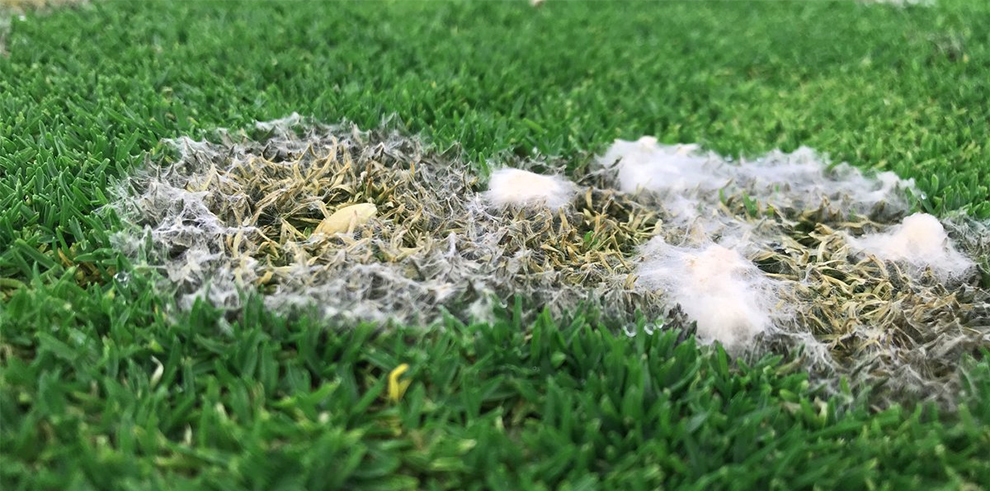
It is a fungal disease that shows in the early spring as the snow melts. Broadly, there are two types of snow mold – pink snow mold and gray snow mold. The former infects the plant’s crown and can cause more severe injury than the gray snow mold that affects merely the leaf tissue.
It usually occurs when an extended period of snow covers the ground, which is not entirely frozen. They may also show under the leaves, which have not been cleaned up, or long grass that has not been mowed down.
How to identify it?
You will see this as circular straw-colored patches with matted grass that looks moldy or gray. It does not kill your grass but looks horrible.
Treatment
You can prevent these lawn fungus types by mowing your lawn down to about two inches late in the season to ensure the grass does not lay over on itself. Fall aeration can also be beneficial.
Typically, these do not require treatment, and the lawn recovers by itself, but light raking can accelerate the process. However, be gentle, as aggressive raking might kill the grass.
E. Powdery mildew

Powdery mildew most commonly affects the Kentucky bluegrass growing in the shade. However, cool air temperatures, high humidity, and improper air circulation might also lead to powdery mildew spread.
How to identify it?
You will spot powdery mildew as white, isolated spore masses on the grass edges. Over time, these white masses might cover the whole blade, making the turf look sprinkled in the flour. Upon closer examination, you might find black-fruiting bodies within the white powdery growth.
The grass that is severely infected will turn yellow and die. However, powdery mildew is rarely a cause of dead turf. In most cases, the weak turf succumbing to other diseases or drought might kill the turf.
Treatment
To treat these types of lawn diseases, you must improve sunlight in the affected area and remove or transplant the plants curtailing air circulation. In addition, applying fungicides with triadimefon, propiconazole, and myclobutanil can also help.
F. Pythium
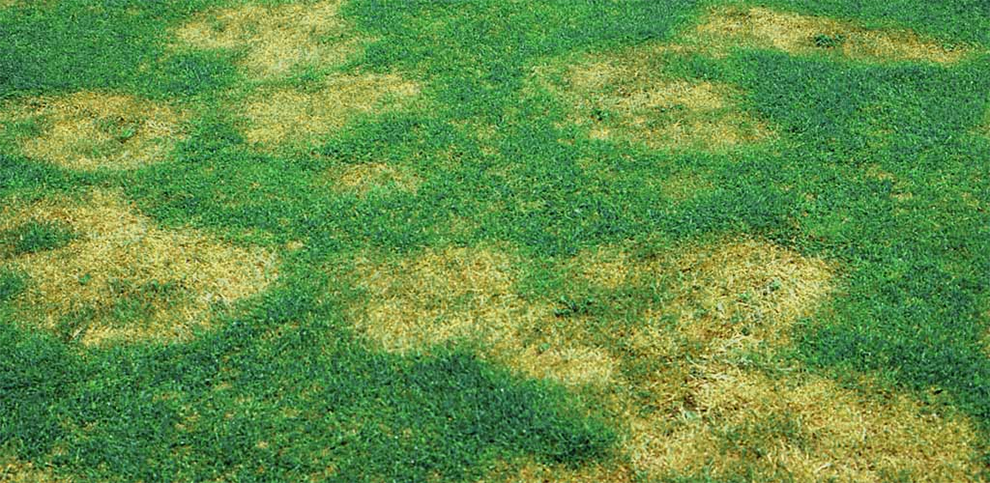
Pythium is seen during humid or hot weather.
How to identify it?
You will see it as irregular or circular spots about one to six inches. Further, if the grass feels greasy or slimy early in the morning, it might also indicate the presence of Pythium. Pythium will kill the grass in these spots, and the dead gross will become shriveled and lightly tanned.
Treatment
Avoid overwatering late in the day and dethatching. In addition, you must not use nitrogen-heavy fertilizers in hot weather. You can find fungicides for the different types of lawn fungus, but sadly there is no such option for Pythium. But you can still find some commercially applied products that can prove beneficial.
G. Gray leaf spot
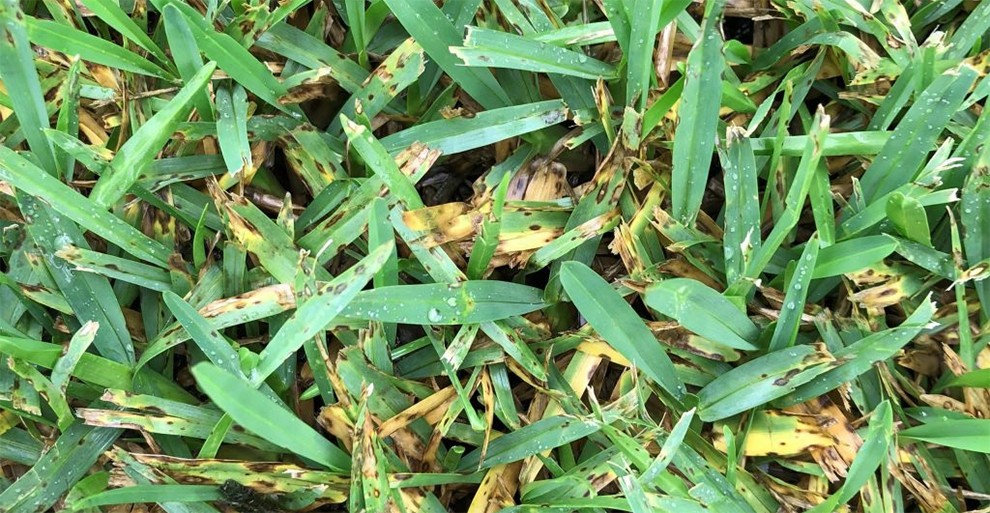
This disease is prevalent in the St. Augustine grass. Pyricularia grisea is the fungus responsible for gray leaf spots, but you can also spot it on tall fescue, perennial ryegrass, and annual ryegrass.
It is an unsightly disease and can ruin the look of even the most beautiful yard in no time. So, immediate steps toward elimination are mandatory.
How do I identify it?
In these types of lawn diseases, the gray leaf spot typically commences with tan to gray spots in the grass blades. They have brown or purple borders and are more common around the center.
Detecting them in cool-season grasses is more challenging because they won’t show any spots but develop pinprick lesions. If you do not take steps toward its treatment, the lesions might become water-soaked and advance to the twisted necrotic leaf tips.
Treatment
Prevention for this fungus is mostly the same as other different types of grass fungus. You need to ensure routine maintenance. So, water and fertilize as per the schedule and frequently inspect the yard to inspect any changes required.
You should not use fungicides for gray leaf spots and leave them as a last resort if natural treatments do not work. However, if nothing works, some fungicides that can help are fluoxastrobin, pyraclostrobin, and azoxystrobin. However, fungicides are a temporary solution. So, be cautious with their use.
H. Red thread
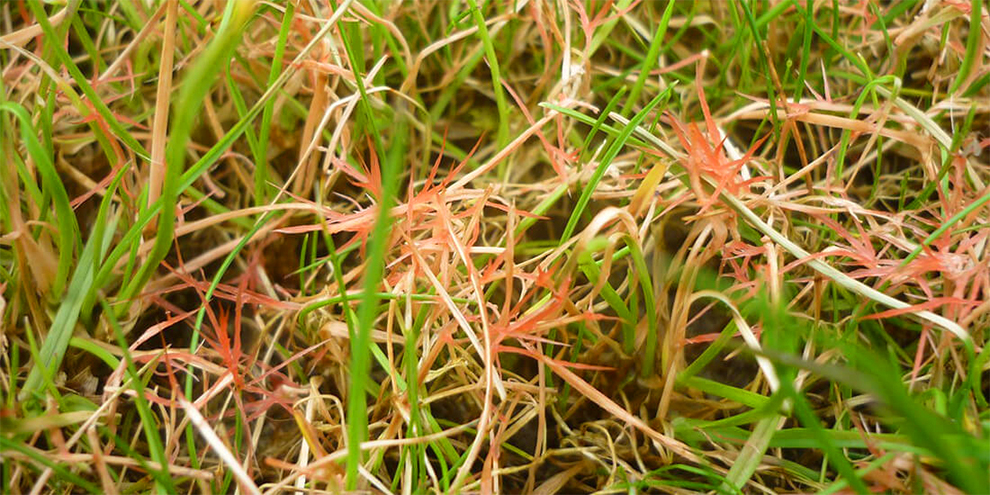
Low nitrogen levels in the soil are the most common cause of red thread. It is a less dangerous one among the different types of lawn fungus. So, use this as an indicator to fertilize the lawn. This disease is prevalent in cool-season grass like ryegrass, red fescue, bentgrass, and Kentucky bluegrass.
How do I identify it?
The red thread looks just as you would expect it to be. It will show as a pink or red thread on the grass. Upon closer inspection, the grass blades look yellow or bleached. Its patches might not be over two feet in diameter.
Treatment
Red threads appear in low-nitrogen soils and climates where the temperature is humid, between 68 and 75 degrees. Experts do not recommend treating them chemically. You can control them by strengthening the existing lawn.
So, keep the soil aerated and fertilize it with recommended nitrogen. The red thread takes two years to thin out and disappear. In extreme cases, you should opt for fungicides with strobilurins but curtail this to professional use.
I. Necrotic ring spot
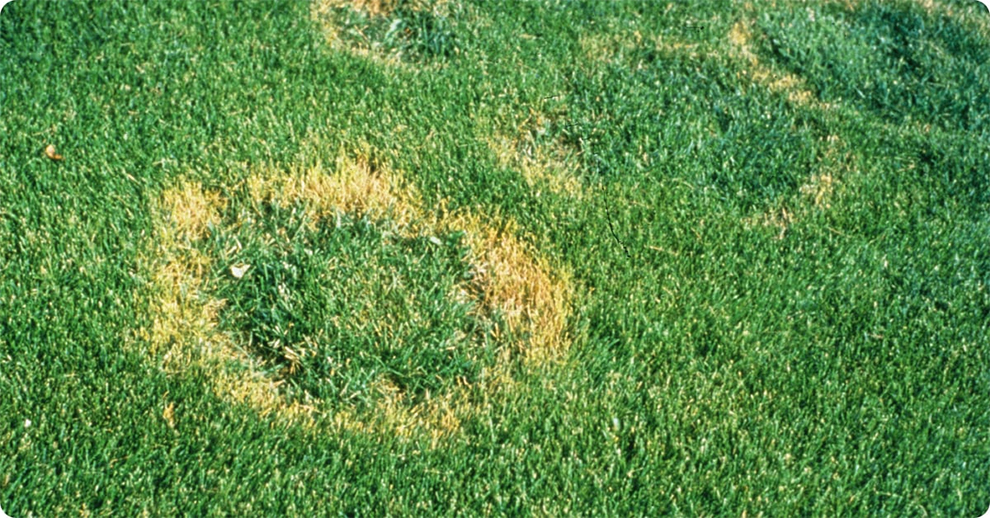
Caused by the Ophiosphaerella Korra fungus, the necrotic ring spot is one of the severe yard fungus types. It mainly affects the Kentucky bluegrass. This fungus feeds on the dead leaves, thatch, and soil and kills the lawn’s root system. It most commonly appears in the wet or cooler spring or fall months.
How do I identify it?
Typically, this disease starts with the grass fading to a light green or yellow before thinning out eventually. You can also identify this fungus from its pattern. The necrotic ring spot will be for frog-eye-like rings in your yard.
These rings are usually 3-15 inches, but in some cases, the patches might extend up to three feet. Sadly if this pattern shows, the grass dies.
Treatment
You can prevent or control the necrotic ring spot with proper maintenance. Following a balanced nitrogen fertilization program, ideal irrigation, and frequent aeration to ensure deep root growth can be beneficial.
You can take the chemical routine, but it is all about the temperature and timing. Apply the fungicide when the fungus is most active when the temperature for three-inch soil is between 60 and 70 degrees.
Typically, the fungus affects the root level. Hence, apply fungicide before or after the irrigation. Fungicides containing fenarimol, propiconazole, or thiophanate-methyl can help correct it.
J. Fairy ring
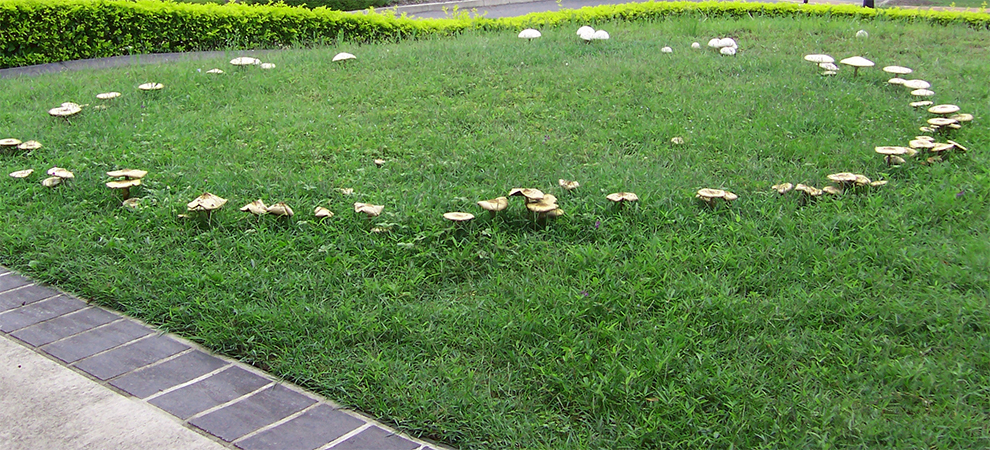
These are naturally occurring arcs of mushrooms in forests or grassed areas.
How do I identify it?
These lawn fungus types can show in complete or incomplete circles and grow around 30 feet in diameter. You can find three kinds of fairy rings on the lawns:
- those with just mushrooms
- those with mushrooms and darkened green rings
- those with mushrooms and dying grass.
Treatment
They do not cause widespread damage but are hard to get rid of. Hence, people usually leave them as is.
K. Summer patch
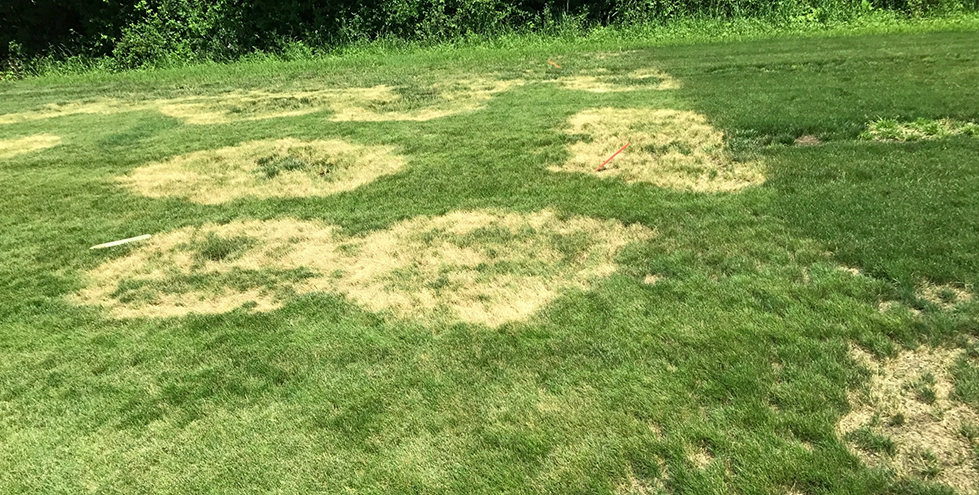
It is a nasty summertime disease arising from the Magnaporthe poae fungi. It primarily affects the cool-season grasses. Typically, the fungus appears in early spring or late spring, but you will not notice any damage signs till the grass is under the highest stress during the late summer.
Sadly once the damage shows in late summer, you cannot do a thing. Hence, prevention is vital.
How do I identify it?
You can identify the summer patch from the two-inch dark-green wilted grass patches that become brown or yellow as the patches grow. In this case, the grass dies from the tip down. Hence, the earlier you catch these yard fungus types, the greater the chances for the turf to survive.
Treatment
If you spot two-inch dark-green wilted patches, you cannot do much as the fungus has already commenced the destruction. Hence, the only treatment is amplifying the irrigation to help the lawn recover.
In the following spring, when the soil temperature reaches 65 degrees Fahrenheit, you can apply a propiconazole fungicide to ensure the summer patch does not return.
Related: How to kill scale on plants | How to get rid of goat heads naturally | How to get rid of aphids | How to control leafhoppers| How to keep weeds out of flower beds
What Causes Lawn/Yard Fungus?
The top causes for the different types of grass fungus include:
1. Overwatering: Excessive watering creates a moist environment conducive to fungal growth. It is particularly true if the yard or lawn is not properly draining, resulting in waterlogged soil.
2. Using infected equipment: Fungal spores can spread from one area to another via contaminated equipment like a lawn trimmer or mower.
3. Poor soil quality: Soil lacking vital nutrients can be a breeding ground for fungal infection. Poor drainage might also result in fungi growth.
4. Weather conditions: Fungi breed in humid and warm conditions or prolonged humid and hot weather.
5. Improper air circulation: A yard or lawn covered or densely shaded with thick thatch might also promote fungal growth.
How To Prevent Lawn Fungus?
To prevent lawn fungus, you must perform proper lawn maintenance activities, such as watering adequately, mowing at the correct height, ensuring good drainage, and bettering soil quality.
If you suspect a fungal disease, you must immediately consult a professional for an accurate diagnosis and treatment.
How To Treat Lawn Fungus?
Treatment for this depends on the types of grass fungus and the intensity of the infection. Some of the general steps you can take are:
1. Identify the type of fungus – For proper treatment, you must know which fungus it is. You can use our identification tips above or call a professional to help you with identification.
2. Curtail moisture – You do not want to risk further fungal growth. So, curtail the moisture levels by promoting air circulation, improving drainage, and reducing watering.
3. Get rid of infected grass – When the fungus has already infected the grass, remove the infected areas and reseed, if necessary.
4. Use a fungicide – A fungicide can help combat the fungus, but please pick a product exquisitely designed for the said fungus.
5. Follow the instructions – Apply the fungicide following the manufacturer’s instructions on the label, including the dosage, timing, and frequency.
6. Continue maintenance – Once you have dealt with the existing fungus, be cautious for the future. So, maintain good lawn care practices, such as improving the soil quality, watering and fertilizing as per schedule, and maintaining the proper mowing height.
What Is The Most Common Lawn Fungus?
Some of the most common types of grass diseases include:
- Brown Patch
- Dollar spot
- Powdery Mildew
- Rust
- Pythium Blight
What Kills Yard Fungus?
You can kill the yard fungus by following one or a combination of the following methods:
- Using a fungicide
- Removing the infected grass.
- Altering the watering schedule.
- Ensuring good air circulation
- Improving soil drainage
Can You Treat Lawn Fungus With A Fungicide?
Yes, a fungicide can help treat lawn fungus. But these chemical treatments must be employed in conjunction with proper lawn maintenance to avoid future fungal infections.
